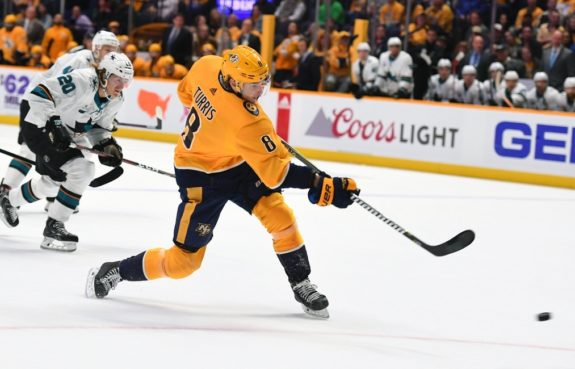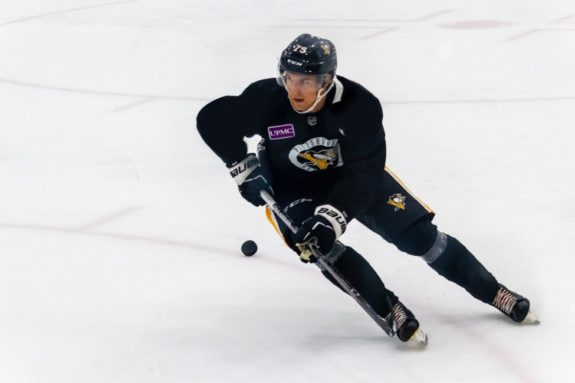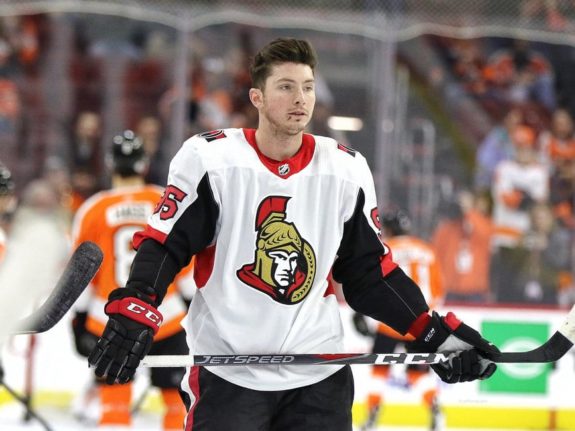On Dec. 18, the Nashville Predators played the Ottawa Senators on the road, marking a return to Ottawa for long-time Senator Kyle Turris. It was not his first game back in Ottawa since his trade to the Predators last season. That matchup occurred in February of last season, but the most recent game was interesting because he remains a fan favorite in Ottawa and also because he fought former teammate Bobby Ryan.
When the Predators acquired Turris from the Senators by way of the Colorado Avalanche on Nov. 5, 2017, it made headlines throughout the hockey world. The trade looked like this:
- To Nashville: Kyle Turris
- To Ottawa: Matt Duchene
- To Colorado: From Ottawa – Andrew Hammond, Shane Bowers, a protected 2018 or 2019 first round pick and a 2019 third round pick; From Nashville – Samuel Girard, Vladislav Kamenev and a 2018 second round pick
For more information on the trade in its entirety and its results a year later, read fellow THW writer Josh Bell’s great article ‘Matt Duchene Trade Analyzed.’ For the purposes of this article, I look at how the trade has played out for the Predators and whether or not the team made the proper decision in acquiring Turris, using the benefit of hindsight.
Why Did the Predators Make the Deal?
The Predators were in need of additional center depth last season when they made the deal for Turris. In 2016-17, when they reached the Stanley Cup Final, their centers included Mike Fisher, Frédérick Gaudreau, Calle Järnkrok, Ryan Johansen and Colton Sissons. Over the following offseason, they added Nick Bonino through free agency, a moved necessitated by Fisher’s retirement. But they still had a hole to fill in the second line center role.

They had long been looking for someone to slot in behind Johansen down the middle and had even been rumored to be interested in Duchene for sometime before they acquired Turris. When they landed Turris, they got a player who is a solid second line center that wins faceoffs and scores around 50 points per season. The result was Nashville having one of the league’s best center depths.
How Has the Trade Worked Out?
In this section, I’m focusing solely on Turris and the assets the Predators gave up to acquire him. Since joining the Predators, Turris has appeared in 92 regular season games and has scored 18 goals and 59 points, including 22 on the power play. He has shot 11.5 percent, the same as his percentage with the Senators, and has averaged 16:02 per game. He has won 49.8 percent of faceoffs and has a plus turnover ratio and positive five-on-five metrics.
He has also averaged .64 points-per-game (P/G) with Nashville while his rate was .67 with Ottawa. So he’s been productive for a second line center. However, in the 2018 Playoffs, he was largely absent with just three assists in 13 games while averaging 15:58 of ice time and winning 45.5 percent of draws.
One of the prospects the Predators gave up is Samuel Girard, a left-shot defenseman whom the team used a 2016 second round pick on. He appeared in five games with the Predators before the trade and totaled one goal and two assists. Since the trade, he has appeared in 103 games with the Avalanche and has five goals and 32 points, with 19 occurring on the man advantage. He has shot 3.9 percent while averaging 18:30 per game.

Although he’s only 20, Girard has shown an ability as an offensive defenseman who can effectively lead a rush while possessing a booming shot from the point. He was another installment in a long line of quality defensemen drafted and developed by the Predators. A line that includes Mattias Ekholm, Ryan Ellis, Seth Jones, Roman Josi, Ryan Suter and Shea Weber.
The other prospect is Russian forward Vladislav Kamenev, former 2014 second round pick of the Predators. He had only appeared in two games with Nashville before the trade but was kept off the scoresheet. At the time of the deal, he was in the AHL where he had three goals and eight points in 10 games.
Since the trade, he has appeared in 26 games with the Avalanche and has tallied two goals and five points. He has averaged just over nine minutes of ice time, has won 48.5 percent of faceoffs and has negative possession metrics. In 2016, he captained Team Russia to a silver medal at the World Junior Championships. He recently went down with a shoulder injury that requires him to undergo surgery.
The last asset the Predators parted with, a 2018 second rounder that became the 58th overall selection, ended up with the Pittsburgh Penguins who used the pick on Swedish forward Filip Hållander. He currently plays for Timra IK in the SHL and will represent Sweden at the 2019 World Junior Championships. So far in 23 games this season, he has five goals and 12 points.

Turris Versus Duchene
With the Duchene-to-Nashville rumors having gone on for multiple seasons, it was somewhat of a surprise that they ended up with Turris. It seemed like an acquisition of Duchene would be a perfect fit. The Predators had a positional need he could fill and he was eager to get out of Colorado. Even the city’s identity as the country music capital of the world seemed to jive with Duchene, a notable fan of the genre and an acoustic guitar player. So did the Predators land the right center? There are several areas I want to look at to answer that question.
Players’ Ages
Turris, born in 1989, is 29 years old and won’t turn 30 until August. He was drafted by the then-Phoenix Coyotes in 2007 and made his NHL debut during the 2007-08 season. Duchene is less than two years younger, with a 1991 birthday. He is currently 27, but turns 28 in January. The Avalanche took him in the 2009 Entry Draft and he debuted that fall.
Contract Statuses
There really wasn’t an advantage between the two players’ contracts at the time of the trade. Both were playing on deals that were set to expire within two seasons. When the trade took place, Turris’ contract was due to expire at the conclusion of the 2017-18 season. He and the Predators agreed to a six-year, $36 million extension on the day he was traded. His new deal increased his cap hit from $3.5 million to $6 million.
Kyle Turris' six-year extension in Nashville does not include a no-trade clause, FYI
— Pierre LeBrun (@PierreVLeBrun) November 6, 2017
Duchene, on the other hand, had one full year left on his deal, making him a free agent after 2018-19. His current contract, a five-year deal that carries a $6 million cap hit, was signed in 2013. When he signed that contract, his cap hit represented 9.33 percent of the upper salary cap limit. According to the NHL Board of Governors’ estimate, the league’s upper limit in 2019-20 is expected to be between $81.4 and $85.4 million. Using the low end of that estimation, his cap hit percentage would equal a cap hit of $7,594,620 next season, still a reasonable cap hit for a player with Duchene’s abilities.
Production Comparisons
Speaking of abilities, let’s look at how each player has performed throughout his career. In 636 career regular season games, Turris has averaged .24 goals-per-game (G/G), .60 P/G and 2.20 shots-per-game (S/G). He has won 50 percent of his faceoffs, has shot 11 percent and has accumulated 40.3 point shares. He also appeared in five postseasons before joining the Predators and totaled 27 points in 46 games.
Duchene has appeared in 683 regular season games in his career with averages of .31 G/G, .75 P/G and 2.46 S/G. He has won 52.9 percent of his draws, has shot 12.7 percent and has totaled 54.0 point shares. He played in two playoff series with the Avalanche and had six points in eight games. Based on rate stats, Duchene has been the more productive player, but who has had the more impressive peak thus far?
Who Has the Higher Upside?
In 2016-17, Turris netted a career-high 27 goals and his personal-best 64 points occurred in 2014-15. Prior to the Coyotes taking him third overall, he played for the Coquitlam Express of the BCHL, a Junior A league in Canada. In his draft year, he had 66 goals and 121 points in 53 games and he played one season with the University of Wisconsin before turning pro. With the Badgers, he had 11 goals and 35 points in 36 games and earned a spot on the conference’s all-rookie team.
Duchene was also drafted third overall. However, he turned pro immediately and finished third in Calder Trophy voting in 2009-10, his rookie season. He played his junior hockey with the OHL’s Brampton Battalion where he had 31 goals and 79 points in 57 games his draft year. Since joining the NHL, he scored a career-high 30 goals in 2015-16 and totaled 70 points in 2013-14. So based on those statistics, Duchene has had the higher upside.
Impact on Teammates this Season
So far this season, Turris has played the majority of his five-on-five ice time on a line with Kevin Fiala and Craig Smith with 112 shared minutes. When together, the line controls at least 50 percent of shots and scoring chances while their control of goals and high danger scoring chances are below 50 percent. Without Turris, Smith and Fiala’s metrics increase to at least 50 percent in all areas except high danger scoring chances.
More recently, however, Turris has played on a line with Järnkrok and Smith with 96 shared minutes. When together, the trio controls well over 50 percent of metrics, including 100 percent of goals. In 100 minutes without Turris on the line, Järnkrok and Smith control at least 50 percent of all metrics except high danger scoring chances.
Duchene mostly plays with Ryan Dzingel and Mark Stone, with 90 minutes together. That line has a negative control of shots, but is over 50 percent in remaining areas. In 57 minutes without Duchene, Dzingel and Stone’s metrics increase in all categories. Therefore, Turris has the more positive impact on his linemates.
Was the Trade Worth It for the Predators?
After presenting all of the evidence, a conclusion must be reached on whether or not acquiring Turris was a good trade for the Predators. While they needed center depth to strengthen their roster for postseason runs, the issue is that Turris hasn’t produced at the same levels that Duchene has. Also in Duchene’s favor are his age and offensive upside. However, in Turris’ favor are his impact on teammates and contract certainty.

But there’s also the fact that Duchene is a left shot while Turris is a right shot. The majority of the Predators’ forwards are right shot and nowhere is this more true than in their top-six. Järnkrok, Johansen, Smith, Viktor Arvidsson, Filip Forsberg and Ryan Hartman are all right shots. Although if you include Kevin Fiala, there is one left shot. Acquiring Duchene instead of Turris would have struck balance in the team’s top-six, something I believe to be an overlooked absence on the roster.
So, considering what the Senators gave up for Duchene versus what the Predators gave up for Turris, I think Nashville GM David Poile went after the wrong player. Perhaps he would have had to throw in a first round pick and/or another prospect in addition to Girard and Kamenev, but it wouldn’t have been too high of an asking price. Yes, they would have still been required to extend Duchene, but they had, and still, have the necessary cap space to make it happen.
However, there’s still a chance the Predators land him. He remains a free agent at season’s end and they could acquire him for less now than they could have last season. With offense a team need, I think it would be a worthwhile deal if Poile were to make it happen. Let me know in the comments below whether you think the Predators traded for the right player and if you think they should go after Duchene again.
*All stats came from Hockey-Reference, Elite Prospects, and Natural Stat Trick